Related Research Articles

Diamond is a solid form of the element carbon with its atoms arranged in a crystal structure called diamond cubic. Another solid form of carbon known as graphite is the chemically stable form of carbon at room temperature and pressure, but diamond is metastable and converts to it at a negligible rate under those conditions. Diamond has the highest hardness and thermal conductivity of any natural material, properties that are used in major industrial applications such as cutting and polishing tools. They are also the reason that diamond anvil cells can subject materials to pressures found deep in the Earth.

A gemstone is a piece of mineral crystal which, in cut and polished form, is used to make jewelry or other adornments. However, certain rocks and occasionally organic materials that are not minerals are also used for jewelry and are therefore often considered to be gemstones as well. Most gemstones are hard, but some soft minerals are used in jewelry because of their luster or other physical properties that have aesthetic value. Rarity and notoriety are other characteristics that lend value to gemstones.

Ruby is an interpreted, high-level, general-purpose programming language which supports multiple programming paradigms. It was designed with an emphasis on programming productivity and simplicity. In Ruby, everything is an object, including primitive data types. It was developed in the mid-1990s by Yukihiro "Matz" Matsumoto in Japan.
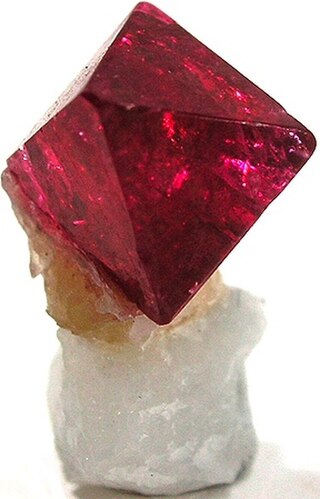
Spinel is the magnesium/aluminium member of the larger spinel group of minerals. It has the formula MgAl
2O
4 in the cubic crystal system. Its name comes from the Latin word spinella, which means spine in reference to its pointed crystals.

Sapphire is a precious gemstone, a variety of the mineral corundum, consisting of aluminium oxide (α-Al2O3) with trace amounts of elements such as iron, titanium, chromium, vanadium, or magnesium. The name sapphire is derived via the Latin "sapphirus" from the Greek "sappheiros", which referred to lapis lazuli. It is typically blue, but natural "fancy" sapphires also occur in yellow, purple, orange, and green colors; "parti sapphires" show two or more colors. Red corundum stones also occur, but are called rubies rather than sapphires. Pink-colored corundum may be classified either as ruby or sapphire depending on locale. Commonly, natural sapphires are cut and polished into gemstones and worn in jewelry. They also may be created synthetically in laboratories for industrial or decorative purposes in large crystal boules. Because of the remarkable hardness of sapphires – 9 on the Mohs scale (the third hardest mineral, after diamond at 10 and moissanite at 9.5) – sapphires are also used in some non-ornamental applications, such as infrared optical components, high-durability windows, wristwatch crystals and movement bearings, and very thin electronic wafers, which are used as the insulating substrates of special-purpose solid-state electronics such as integrated circuits and GaN-based blue LEDs. Sapphire is the birthstone for September and the gem of the 45th anniversary. A sapphire jubilee occurs after 65 years.
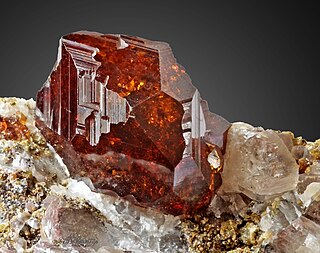
Garnets are a group of silicate minerals that have been used since the Bronze Age as gemstones and abrasives.

A ruby is a pinkish red to blood-red colored gemstone, a variety of the mineral corundum. Ruby is one of the most popular traditional jewelry gems and is very durable. Other varieties of gem-quality corundum are called sapphires. Ruby is one of the traditional cardinal gems, alongside amethyst, sapphire, emerald, and diamond. The word ruby comes from ruber, Latin for red. The color of a ruby is due to the element chromium.

Peridot, sometimes called chrysolite, is a deep yellowish-green transparent variety of olivine. Peridot is one of the few gemstones that occurs in only one color.

The Cullinan Diamond is the largest gem-quality rough diamond ever found, weighing 3,106 carats (621.20 g), discovered at the Premier No.2 mine in Cullinan, South Africa, on 26 January 1905. It was named after Thomas Cullinan, the owner of the mine. In April 1905, it was put on sale in London, but despite considerable interest, it was still unsold after two years. In 1907, the Transvaal Colony government bought the Cullinan and Prime Minister Louis Botha presented it to Edward VII, the British king who reigned over the territory, and it was cut by Joseph Asscher & Co. in Amsterdam.

Nepheline, also called nephelite (from Ancient Greek νεφέλη (nephélē) 'cloud'), is a rock-forming mineral in the feldspathoid group – a silica-undersaturated aluminosilicate, Na3KAl4Si4O16, that occurs in intrusive and volcanic rocks with low silica, and in their associated pegmatites. It is used in glass and ceramic manufacturing and other industries, and has been investigated as an ore of aluminium.
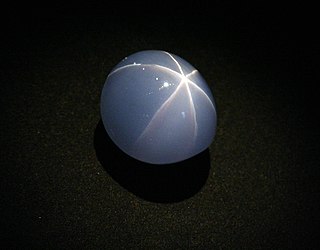
The Star of India is a 563.35-carat star sapphire, one of the largest such gems in the world. It is almost flawless and is unusual in that it has stars on both sides of the stone. The greyish-blue gem was mined in Sri Lanka and is housed in the American Museum of Natural History in New York City.
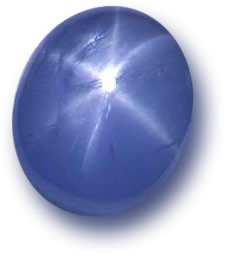
An asterism is a star-shaped concentration of reflected or refracted light from a gemstone. Asterisms can appear when a suitable stone is cut en cabochon i.e. shaped and polished.

The Verneuil method, also called flame fusion, was the first commercially successful method of manufacturing synthetic gemstones, developed in the late 1883 by the French chemist Auguste Verneuil. It is primarily used to produce the ruby, sapphire and padparadscha varieties of corundum, as well as the diamond simulants rutile, strontium titanate and spinel. The principle of the process involves melting a finely powdered substance using an oxyhydrogen flame, and crystallising the melted droplets into a boule. The process is considered to be the founding step of modern industrial crystal growth technology, and remains in wide use to this day.
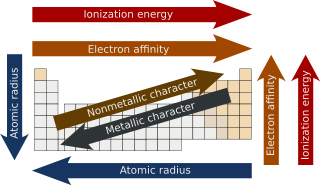
Periodic trends are specific patterns that are present in the periodic table that illustrate different aspects of a certain element. They were discovered by the Russian chemist Dmitri Mendeleev in the year 1863. Major periodic trends include atomic radius, ionization energy, electron affinity, electronegativity, valency and metallic character. These trends exist because of the similar electronic configuration of the elements within their respective groups or periods and because of the periodic nature of the elements. These give a qualitative assessment of the properties of each element.
The largest flawless diamond in the world is known as The Paragon, a D-color gem weighing 137.82 carats (27.564 g), and the tenth largest white diamond in the world. The gem was mined in Brazil and attracted attention for being an exceptional white, flawless stone of great size. The Mayfair-based jeweller Graff Diamonds acquired the stone in Antwerp, cut it into an unusual seven-sided kite shield configuration, and set it in a necklace which separates to both necklace and bracelet lengths. Apart from the main stone, this necklace also contains rare pink, blue, and yellow diamonds, making a total mass of 190.27 carats (38.054 g). The necklace has associations with the end of the millennium and was worn by model Naomi Campbell at a diamond gala held by De Beers and Versace at Syon House in 1999.

Gemini is one of the constellations of the zodiac and is located in the northern celestial hemisphere. It was one of the 48 constellations described by the 2nd century AD astronomer Ptolemy, and it remains one of the 88 modern constellations today. Its name is Latin for twins, and it is associated with the twins Castor and Pollux in Greek mythology. Its old astronomical symbol is (♊︎).
The Timur Ruby is an unfaceted, 352.54-carat (71 g) polished red spinel set in a necklace. It is named after the ruler Timur, founder of the Timurid Empire and purportedly one of its former owners. It was believed to be a ruby until 1851.
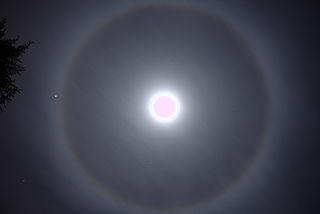
Optical phenomena are any observable events that result from the interaction of light and matter.

The Sunrise Ruby is the world's most expensive ruby, most expensive coloured gemstone, and most expensive gemstone other than a diamond.
The Star of Adam is an oval-shaped blue star sapphire, currently the largest star sapphire in the world. It weighs 1,404.49 carats. Prior to its discovery, the Black Star of Queensland, weighing 733 carats (146.6 g), was the largest star sapphire gem in the world.
References
- 1 2 Manutchehr-Danai, Mohsen, ed. (2009), "Neelanjali Star Ruby", Dictionary of Gems and Gemology, Berlin, Heidelberg: Springer, p. 597, doi:10.1007/978-3-540-72816-0_15103, ISBN 978-3-540-72816-0 , retrieved 2022-12-02
- ↑ Bouysse, Philippe; Girault, François (2018-11-13). Gemmes, pierres, métaux, substances utiles: Florilège, de l'Antiquité aux Temps modernes (in French). Editions Publibook. ISBN 978-2-342-16409-1.